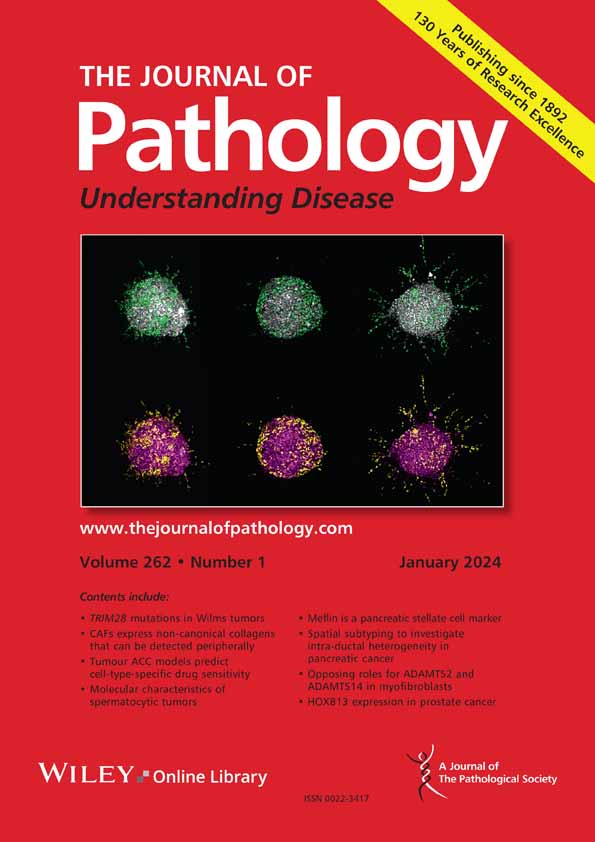Yoshitsugu Mitani, Haneen Al-Maghrabi, Tatiana V Karpinets, Raissa T Relator, Lauren Hilder, Irene Y Chen, Ryan P Goepfert, Diana Bell, Jianhua Zhang, Renata Ferrarotto, Adel K El-Naggar
求助PDF
{"title":"唾液基底细胞腺瘤和腺癌的比较转录组学维持线性肿瘤进化和肿瘤间异质性:分类和生物学意义。","authors":"Yoshitsugu Mitani, Haneen Al-Maghrabi, Tatiana V Karpinets, Raissa T Relator, Lauren Hilder, Irene Y Chen, Ryan P Goepfert, Diana Bell, Jianhua Zhang, Renata Ferrarotto, Adel K El-Naggar","doi":"10.1002/path.6424","DOIUrl":null,"url":null,"abstract":"<p>It remains uncertain whether basal cell adenoma (BCA) and basal cell adenocarcinoma (BCAC) of the salivary gland represent two distinct neoplasms or temporal stages of a single entity. The issue is central to reconciling their shared phenotypic resemblance and protracted behavior with current pathologic classification. We conducted a transcriptomic analysis on a cohort of both pathologic forms and correlated the findings with the clinicopathologic features using RNA extracted from fresh frozen samples of 25 salivary basal tumors (five BCAs and 20 BCACs) and eight instances of metastatic basal cell carcinomas (BCCs) to parotid glands. Unsupervised analysis revealed shared and intertumoral transcriptome differences within and between BCA and BCAC and distinct segregation from metastatic dermal BCC. Transcriptomic profiling delineated two intermixed subgroups of salivary basal cell neoplasms (SBNs); SBN-I group enriched with adverse pathologic features and SBN-II that lacked any of these features except for a single case. The category with the most instances of adverse pathologic features (SBN-I) manifested upregulations of transcriptional factors linked to cell proliferation pathways (<i>HOXB13</i>, <i>SOX21</i>, <i>MYB</i>, and <i>EN1</i> genes), while those lacking adverse pathologic features (SBN-II) demonstrated a high expression of the <i>TFAP2B</i> transcription- and differentiation-related pathways. Our transcriptomic findings support common neoplastic evolution and intertumoral heterogeneity of both pathologic forms of basal cell neoplasms and identify molecular pathways of potential biological and clinical significance. We therefore propose a nondeterministic designation of ‘basal cell salivary neoplasms, noninvasive (adenoma)/invasive (adenocarcinoma)’ as a platform that integrates conventional phenotypic classification and transcriptomic characteristics pending a classification consensus. © 2025 The Pathological Society of Great Britain and Ireland.</p>","PeriodicalId":232,"journal":{"name":"The Journal of Pathology","volume":"266 3","pages":"258-267"},"PeriodicalIF":5.2000,"publicationDate":"2025-04-24","publicationTypes":"Journal Article","fieldsOfStudy":null,"isOpenAccess":false,"openAccessPdf":"","citationCount":"0","resultStr":"{\"title\":\"Comparative transcriptomics of salivary basal cell adenoma and adenocarcinoma sustain linear neoplastic evolution and intertumor heterogeneity: classification and biological implications\",\"authors\":\"Yoshitsugu Mitani, Haneen Al-Maghrabi, Tatiana V Karpinets, Raissa T Relator, Lauren Hilder, Irene Y Chen, Ryan P Goepfert, Diana Bell, Jianhua Zhang, Renata Ferrarotto, Adel K El-Naggar\",\"doi\":\"10.1002/path.6424\",\"DOIUrl\":null,\"url\":null,\"abstract\":\"<p>It remains uncertain whether basal cell adenoma (BCA) and basal cell adenocarcinoma (BCAC) of the salivary gland represent two distinct neoplasms or temporal stages of a single entity. The issue is central to reconciling their shared phenotypic resemblance and protracted behavior with current pathologic classification. We conducted a transcriptomic analysis on a cohort of both pathologic forms and correlated the findings with the clinicopathologic features using RNA extracted from fresh frozen samples of 25 salivary basal tumors (five BCAs and 20 BCACs) and eight instances of metastatic basal cell carcinomas (BCCs) to parotid glands. Unsupervised analysis revealed shared and intertumoral transcriptome differences within and between BCA and BCAC and distinct segregation from metastatic dermal BCC. Transcriptomic profiling delineated two intermixed subgroups of salivary basal cell neoplasms (SBNs); SBN-I group enriched with adverse pathologic features and SBN-II that lacked any of these features except for a single case. The category with the most instances of adverse pathologic features (SBN-I) manifested upregulations of transcriptional factors linked to cell proliferation pathways (<i>HOXB13</i>, <i>SOX21</i>, <i>MYB</i>, and <i>EN1</i> genes), while those lacking adverse pathologic features (SBN-II) demonstrated a high expression of the <i>TFAP2B</i> transcription- and differentiation-related pathways. Our transcriptomic findings support common neoplastic evolution and intertumoral heterogeneity of both pathologic forms of basal cell neoplasms and identify molecular pathways of potential biological and clinical significance. We therefore propose a nondeterministic designation of ‘basal cell salivary neoplasms, noninvasive (adenoma)/invasive (adenocarcinoma)’ as a platform that integrates conventional phenotypic classification and transcriptomic characteristics pending a classification consensus. © 2025 The Pathological Society of Great Britain and Ireland.</p>\",\"PeriodicalId\":232,\"journal\":{\"name\":\"The Journal of Pathology\",\"volume\":\"266 3\",\"pages\":\"258-267\"},\"PeriodicalIF\":5.2000,\"publicationDate\":\"2025-04-24\",\"publicationTypes\":\"Journal Article\",\"fieldsOfStudy\":null,\"isOpenAccess\":false,\"openAccessPdf\":\"\",\"citationCount\":\"0\",\"resultStr\":null,\"platform\":\"Semanticscholar\",\"paperid\":null,\"PeriodicalName\":\"The Journal of Pathology\",\"FirstCategoryId\":\"3\",\"ListUrlMain\":\"https://pathsocjournals.onlinelibrary.wiley.com/doi/10.1002/path.6424\",\"RegionNum\":2,\"RegionCategory\":\"医学\",\"ArticlePicture\":[],\"TitleCN\":null,\"AbstractTextCN\":null,\"PMCID\":null,\"EPubDate\":\"\",\"PubModel\":\"\",\"JCR\":\"Q1\",\"JCRName\":\"ONCOLOGY\",\"Score\":null,\"Total\":0}","platform":"Semanticscholar","paperid":null,"PeriodicalName":"The Journal of Pathology","FirstCategoryId":"3","ListUrlMain":"https://pathsocjournals.onlinelibrary.wiley.com/doi/10.1002/path.6424","RegionNum":2,"RegionCategory":"医学","ArticlePicture":[],"TitleCN":null,"AbstractTextCN":null,"PMCID":null,"EPubDate":"","PubModel":"","JCR":"Q1","JCRName":"ONCOLOGY","Score":null,"Total":0}
引用次数: 0
引用
批量引用




 求助内容:
求助内容: 应助结果提醒方式:
应助结果提醒方式:


